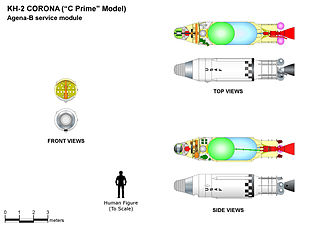
The SAMOS or SAMOS-E program was a relatively short-lived series of reconnaissance satellites for the United States in the early 1960s, also used as a cover for the initial development of the KH-7 GAMBIT system. Reconnaissance was performed with film cameras and television surveillance from polar low Earth orbits with film canister returns and transmittals over the United States. SAMOS was first launched in 1960 from Vandenberg Air Force Base.
Discoverer 30, also known as Corona 9022, was an American optical reconnaissance satellite which was launched in 1961. It was a KH-3 Corona''' satellite, based on an Agena-B rocket.

Discoverer 25, also known as Corona 9017, was an American optical reconnaissance satellite which was launched in 1961. It was the fifth of ten Corona KH-2 satellites, based on the Agena-B.
OPS 3762, also known as FTV-2355, was an American reconnaissance satellite which was launched in 1964. It was the first radar imaging satellite to be launched, and the only Quill spacecraft to fly. Its mission was to demonstrate radar imaging techniques for future missions. However, the programme was cancelled before any more satellites were launched.
Samos 2 was an American reconnaissance satellite launched in 1961 as part of the Samos program. It was an early electro-optical reconnaissance spacecraft, meaning that it transmitted images to receiving stations on Earth rather than returning them in a film capsule. Samos 2 was a Samos-E1 spacecraft, based on an Agena-A.
Samos 3 was an American reconnaissance satellite which was lost in a launch failure in 1961. It was an early electro-optical reconnaissance spacecraft, meaning that it transmitted images to receiving stations on Earth rather than returning them in a film capsule, and was to have been operated as part of the Samos programme. Samos 3 was the only Samos-E2 spacecraft to be launched. Samos-E2 satellites were based on an Agena-B, and carried a camera with a focal length of 91 centimetres (36 in), and a resolution of 6 metres (20 ft).
Samos 4 was an American reconnaissance satellite which was lost in a launch failure in 1961. It was a film-return reconnaissance spacecraft, meaning that it returned images in a film capsule at the end of its mission. It was operated as part of the Samos programme. Samos 4 was the first of three Samos-E5 spacecraft to be launched; Samos-E5 satellites were based on an Agena-B, and carried a camera with a focal length of 1.67 metres, and a resolution of 1.5 metres.
FTV-1126, also known as Corona 9034A, was an American area survey optical reconnaissance satellite launched in 1962. It was a KH-5 Argon satellite, based on an Agena-B. It was also unofficially known as Discoverer 41, a continuation of the designation sequence used for previous US reconnaissance satellites, which had officially been discontinued after Discoverer 38. It was the first KH-5 satellite to complete its mission successfully.
FTV-1132, also known as the Corona 9042A, was an American area survey optical reconnaissance satellite which was launched in 1962. It was a KH-5 Argon satellite, based on an Agena-B. The satellite operated successfully, but its film capsule was lost during recovery due to a parachute failure.

Discoverer 26, also known as Corona 9019, was an American optical reconnaissance satellite which was launched in 1961. It was the sixth of ten Corona KH-2 satellites, based on the Agena-B.

Discoverer 18, also known as Corona 9013, was an American optical reconnaissance satellite launched on 7 December 1960 at 20:24:00 GMT. It was the first successful, and the third of ten total Corona KH-2 satellites, based on the Agena-B.
Discoverer 29, also known as Corona 9023, was an American optical reconnaissance satellite which was launched in 1961. It was the first KH-3 Corona''' satellite, which was based on an Agena-B rocket.
Discoverer 31, also known as Corona 9024, was an American optical reconnaissance satellite which was launched in 1961. It was a KH-3 Corona''' satellite, based on an Agena-B.
Discoverer 32, also known as Corona 9025, was an American optical reconnaissance satellite which was launched in 1961. It was a KH-3 Corona''' satellite, based on an Agena-B.

Discoverer 35, also known as Corona 9028, was an American optical reconnaissance satellite which was launched in 1961. It was the last of ten Corona KH-2 satellites, based on the Agena-B.
Discoverer 36, also known as Corona 9029, was an American optical reconnaissance satellite which was launched in 1961. It was a KH-3 Corona satellite, based on an Agena-B rocket. It was the penultimate KH-3 satellite to be launched, the last successful mission, and the most successful of the program.

Discoverer 5, also known as Corona 9002, was an American optical reconnaissance satellite launched on 13 August 1959 at 19:00:08 GMT, the second of ten operational flights of the Corona KH-1 spy satellite series. Though the satellite was successfully orbited, the onboard camera failed within the first orbit, and the film-return capsule failed to deorbit as planned.

Discoverer 6, also known as Corona 9003, was an American optical reconnaissance satellite launched on 19 August 1959 at 19:24:44 GMT, the third of ten operational flights of the Corona KH-1 spy satellite series. Though the spacecraft was orbited successfully, the onboard camera ceased operating by the second orbit, and the film-return capsule could not be recovered.

Discoverer 7, also known as Corona 9004, was an American optical reconnaissance satellite launched on 7 November 1959 at 20:28:41 GMT, the fourth of ten operational flights of the Corona KH-1 spy satellite series. Though the satellite was orbited successfully, its film capsule failed to separate from the main satellite.

Discoverer 8, also known as Corona 9005, was an American optical reconnaissance satellite launched on 20 November 1959 at 19:25:24 GMT, the fifth of ten operational flights of the Corona KH-1 spy satellite series. Overburn by the carrier rocket placed the satellite in a higher apogee, more eccentric orbit than planned, the camera failed to operate, and the film return capsule was lost on reentry after separation from the main satellite on 21 November.


